现代汉语中声音象征意义
现代汉语名词解释

现代汉语名词解释现代汉语名词解释题第一章:绪论1.现代汉语:现代汉语是现代汉民族所使用的语言。
2.语言:语言是以语音为物质外壳(形式),以词汇为建筑材料,以语法为结构规律的一种音义结合的符号系统。
3.文学语言:文学语言,又称标准语,是现代汉民族语言中经过高度加工并符合规范化的语言。
4.现代汉民族共同语:(普通话)以北京语音为标准音,以北方话为基础方言,以典范的现代白话文著作为语法规范。
5.方言:方言俗称地方话,它是民族语言的地方分支,只通行于一定的地域,是局部地区的人民使用的语言。
6.基础方言:作为民族共同语的基础的方言就叫做基础方言。
第二章:语音1.语音:从人的发音器官发出的,负载一定意义的声音叫语音。
2.音高:音高指的是声音的高低,它决定于发音体颤动的快慢。
3.音强:音强指的是声音的强弱,它与发音体颤动的幅度的大小有关。
4.音长:音长指的是声音的是非,它决定于发音体的颤动的工夫的久暂。
5.音色:音色又叫“音质”,指的是声音的特色。
音色的差别首要决定于物体颤动所形成的音波波纹的曲折体式格局不同。
6.音素:音素是最小的语音单位。
它是从音色的角度划分出来的。
7.辅音:辅音是气流在口腔或喉头受障碍而形成的音素。
8.元音:元音是气流颤动声带,在口腔、咽头不受障碍而形成的音素。
9.音节:音节由音素构成,是交谈时自然感觉到的最小语音单位。
10.声母:声母,位于音节前段,首要由辅音构成。
11.韵母:韵母,位于音节的后段,由元音或元音加辅音构成。
12.声调:声调,指的是依附在声韵结构中具有区别意义作用的音高变化。
13.音位:音位是一个语音系统中能够区别意义的最小的语音单位,也就是按语音的辨义作用归纳出的音类。
14.发音部位:发音时,气流受到阻碍的位置叫做发音部位。
15.声母的发音方法:指的是,发音时喉头,口腔和鼻腔节制气流的体式格局和状况。
16.调值:调值指音节高低升降曲直是非的变化体式格局,也就是声调的实际音值或读法。
《现代汉语》知识要点

《现代汉语》知识要点1. 现代汉民族共同语是“以北京语音为标准音,以北方话为基础方言,以典范的现代白话文著作为语法规范”的普通话。
2.“普通话”一词最早见于1906年朱文熊的《江苏新字母》一书,旧称“官话”、“国语”。
3. 方言是民族语言的地方分支,是局部地区的人们使用的语言,俗称“地方话”。
4.我国民族语言的数目达80种以上。
民族文字目前正在使用的有40种,历史上曾经使用的有近20种,加起来共有近60种。
5.语言是人类最重要的交际工具。
6.汉语属于汉藏语系——汉语族——汉语支7. 语音是人的发音器官发出的能够表示一定意义的声音。
8.音高是声音的高低,取决于发音体振动的快慢。
音高在语音中主要体现在声调上。
9. 声音的强弱,与发音体振动幅度的大小有关。
音强在语音中主要体现在重音上。
10. 声音的长短,决定于发音体振动的时间长短。
语音中的语调、轻声都与音长密切相关。
11. 音色(音质) :声音的特色,决定于物体振动所形成的音波波纹的曲折形式不同。
音色在语音中表现为区分元辅音。
12.音节是语音的基本结构单位,也是语流里最自然的语音单位,它是人们听觉上自然感到的最小语音片断。
13.音素是最小的语音单位,它是从音色的角度划分的出来。
14.音素是构成音节的单位,有的音节由一个音素构成,有的音节由两个或三个音素构成,普通话中一个音节包含最多的有四个音素。
15.气流振动声带,在口腔不受显著阻碍而形成的音叫元音。
气流在口腔中受到明显阻碍而形成的音是辅音。
普通话中共有10个元音音位、22个辅音音位和4个调位。
16.《汉语拼音方案》是1958年2月11日由第一届全国人民代表大会第五次会议批准,国务院发布推行的,是国家制定的拼写汉语、汉字的法定标准。
17.声母是一个音节开头的辅音。
18. 单韵母发音的特点是:发音时舌位和口形始终保持不变。
19.韵腹是韵母的主干,是开口度最大、声音最清晰响亮的元音20. 声调是音节中具有区别意义作用的音高变化。
简述汉语四声的意义
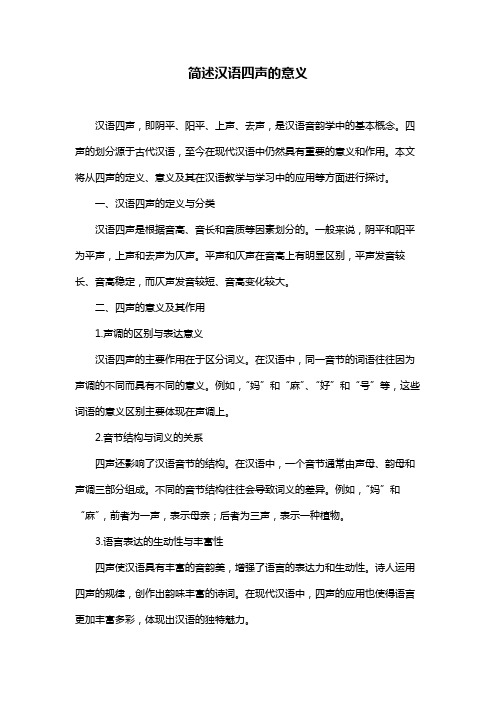
简述汉语四声的意义汉语四声,即阴平、阳平、上声、去声,是汉语音韵学中的基本概念。
四声的划分源于古代汉语,至今在现代汉语中仍然具有重要的意义和作用。
本文将从四声的定义、意义及其在汉语教学与学习中的应用等方面进行探讨。
一、汉语四声的定义与分类汉语四声是根据音高、音长和音质等因素划分的。
一般来说,阴平和阳平为平声,上声和去声为仄声。
平声和仄声在音高上有明显区别,平声发音较长、音高稳定,而仄声发音较短、音高变化较大。
二、四声的意义及其作用1.声调的区别与表达意义汉语四声的主要作用在于区分词义。
在汉语中,同一音节的词语往往因为声调的不同而具有不同的意义。
例如,“妈”和“麻”、“好”和“号”等,这些词语的意义区别主要体现在声调上。
2.音节结构与词义的关系四声还影响了汉语音节的结构。
在汉语中,一个音节通常由声母、韵母和声调三部分组成。
不同的音节结构往往会导致词义的差异。
例如,“妈”和“麻”,前者为一声,表示母亲;后者为三声,表示一种植物。
3.语言表达的生动性与丰富性四声使汉语具有丰富的音韵美,增强了语言的表达力和生动性。
诗人运用四声的规律,创作出韵味丰富的诗词。
在现代汉语中,四声的应用也使得语言更加丰富多彩,体现出汉语的独特魅力。
三、四声在汉语教学与学习中的应用四声是汉语学习的基本内容之一。
掌握四声规律,对提高汉语水平、提高口语和书面表达能力具有重要意义。
在学习汉语的过程中,教师会重点讲解四声的划分、发音特点和应用规律,帮助学生熟练运用四声。
四、四声在现代汉语中的传承与发展随着社会的发展,汉语四声在现代汉语中的地位依然稳固。
在信息化时代,四声规律在拼音输入法、语音识别等领域发挥着重要作用。
同时,汉语四声也被越来越多的人所关注和传承,成为汉语独特魅力的象征。
总之,汉语四声是汉语音韵学的基本概念,具有重要的意义和作用。
掌握四声规律,对提高汉语水平、丰富语言表达具有积极意义。
《仪式、音声及其象征》范文
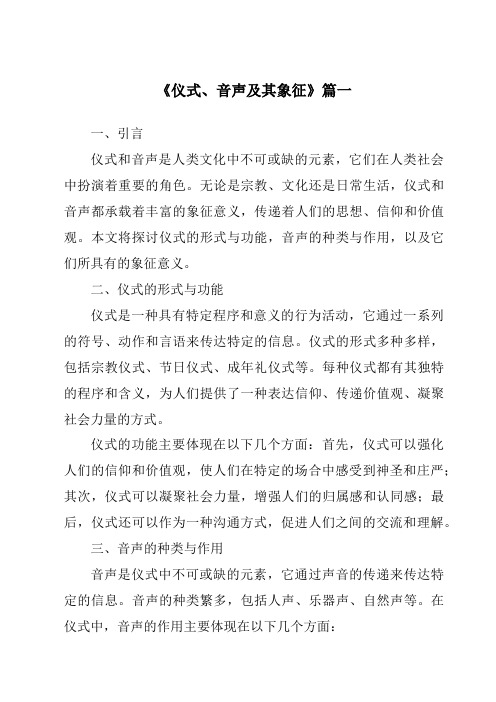
《仪式、音声及其象征》篇一一、引言仪式和音声是人类文化中不可或缺的元素,它们在人类社会中扮演着重要的角色。
无论是宗教、文化还是日常生活,仪式和音声都承载着丰富的象征意义,传递着人们的思想、信仰和价值观。
本文将探讨仪式的形式与功能,音声的种类与作用,以及它们所具有的象征意义。
二、仪式的形式与功能仪式是一种具有特定程序和意义的行为活动,它通过一系列的符号、动作和言语来传达特定的信息。
仪式的形式多种多样,包括宗教仪式、节日仪式、成年礼仪式等。
每种仪式都有其独特的程序和含义,为人们提供了一种表达信仰、传递价值观、凝聚社会力量的方式。
仪式的功能主要体现在以下几个方面:首先,仪式可以强化人们的信仰和价值观,使人们在特定的场合中感受到神圣和庄严;其次,仪式可以凝聚社会力量,增强人们的归属感和认同感;最后,仪式还可以作为一种沟通方式,促进人们之间的交流和理解。
三、音声的种类与作用音声是仪式中不可或缺的元素,它通过声音的传递来传达特定的信息。
音声的种类繁多,包括人声、乐器声、自然声等。
在仪式中,音声的作用主要体现在以下几个方面:首先,音声可以营造氛围,使人们更好地融入仪式中;其次,音声可以传达情感,使人们感受到仪式的庄严和神圣;最后,音声还可以作为一种沟通工具,促进人与人之间的交流和理解。
四、仪式与音声的象征意义仪式和音声在人类文化中具有丰富的象征意义。
首先,仪式象征着一种传统、一种信仰和一种文化。
它通过特定的程序和动作来传达人们的信仰和价值观,使人们在参与过程中感受到文化的传承和积淀。
其次,音声在仪式中扮演着重要的角色,它通过声音的传递来传达人们的情感和思想。
不同的音声具有不同的象征意义,如庄严的钟声象征着神圣和庄重,欢快的鼓点则传递着喜悦和激情。
五、结论综上所述,仪式和音声在人类文化中具有重要的作用。
它们不仅是一种传统、一种信仰的体现,还是一种文化传承和社会凝聚的力量。
在仪式中,音声的传递使人们更好地融入其中,感受到仪式的庄严和神圣。
《仪式、音声及其象征》范文
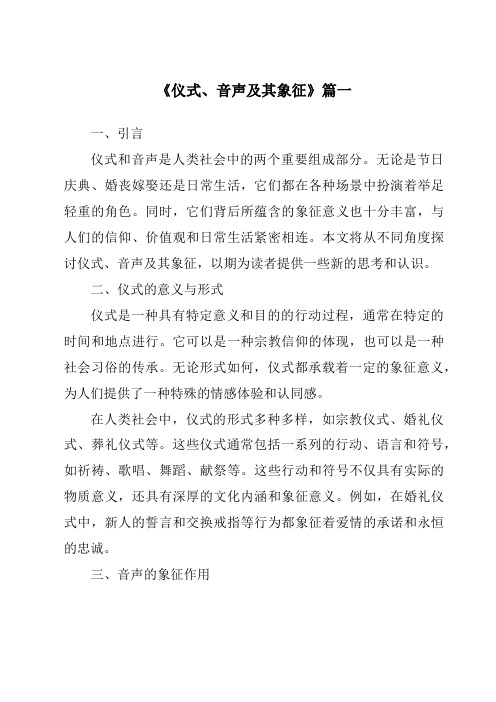
《仪式、音声及其象征》篇一一、引言仪式和音声是人类社会中的两个重要组成部分。
无论是节日庆典、婚丧嫁娶还是日常生活,它们都在各种场景中扮演着举足轻重的角色。
同时,它们背后所蕴含的象征意义也十分丰富,与人们的信仰、价值观和日常生活紧密相连。
本文将从不同角度探讨仪式、音声及其象征,以期为读者提供一些新的思考和认识。
二、仪式的意义与形式仪式是一种具有特定意义和目的的行动过程,通常在特定的时间和地点进行。
它可以是一种宗教信仰的体现,也可以是一种社会习俗的传承。
无论形式如何,仪式都承载着一定的象征意义,为人们提供了一种特殊的情感体验和认同感。
在人类社会中,仪式的形式多种多样,如宗教仪式、婚礼仪式、葬礼仪式等。
这些仪式通常包括一系列的行动、语言和符号,如祈祷、歌唱、舞蹈、献祭等。
这些行动和符号不仅具有实际的物质意义,还具有深厚的文化内涵和象征意义。
例如,在婚礼仪式中,新人的誓言和交换戒指等行为都象征着爱情的承诺和永恒的忠诚。
三、音声的象征作用音声是仪式中不可或缺的元素之一。
它不仅具有传达信息的功能,还具有强烈的象征意义。
在各种仪式中,音声往往被用来表达人们的情感、信仰和价值观。
音声的象征作用体现在多个方面。
首先,不同的音调和节奏可以传达出不同的情感和气氛。
例如,欢快的音乐可以带来喜悦和兴奋的感觉,而悲伤的音乐则可能引发人们的同情和哀悼。
其次,特定的歌曲或旋律可能具有特定的文化内涵和历史背景,成为一种文化传承的载体。
最后,音声还可以作为一种沟通工具,帮助人们建立情感联系和社会认同。
四、仪式与音声的相互关系仪式和音声之间存在着密切的相互关系。
一方面,音声是仪式的重要组成部分,为仪式提供了必要的氛围和情感支持;另一方面,仪式也为音声提供了展示和传承的平台。
在仪式中,音声通过其独特的旋律、节奏和歌词来传达特定的信息和情感。
这些音声不仅在视觉上给人以美的享受,还在心灵上产生共鸣,使人们更加深入地理解和体验仪式的意义。
同时,仪式的进行也离不开音声的陪伴和烘托,它为整个仪式营造出一种特殊的氛围,使参与者能够更好地融入其中,感受到仪式的神圣和庄重。
《现代汉语》名词解释
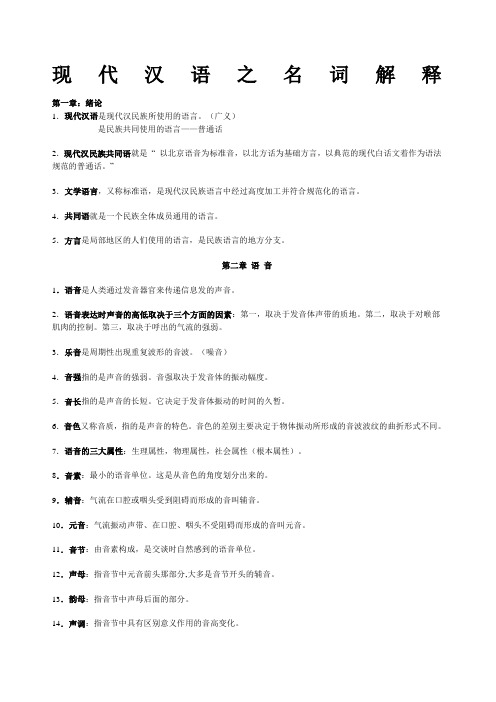
现代汉语之名词解释第一章:绪论1.现代汉语是现代汉民族所使用的语言。
(广义)是民族共同使用的语言——普通话2.现代汉民族共同语就是“ 以北京语音为标准音,以北方话为基础方言,以典范的现代白话文着作为语法规范的普通话。
”3.文学语言,又称标准语,是现代汉民族语言中经过高度加工并符合规范化的语言。
4.共同语就是一个民族全体成员通用的语言。
5.方言是局部地区的人们使用的语言,是民族语言的地方分支。
第二章语音1.语音是人类通过发音器官来传递信息发的声音。
2.语音表达时声音的高低取决于三个方面的因素:第一,取决于发音体声带的质地。
第二,取决于对喉部肌肉的控制。
第三,取决于呼出的气流的强弱。
3.乐音是周期性出现重复波形的音波。
(噪音)4.音强指的是声音的强弱。
音强取决于发音体的振动幅度。
5.音长指的是声音的长短。
它决定于发音体振动的时间的久暂。
6.音色又称音质,指的是声音的特色。
音色的差别主要决定于物体振动所形成的音波波纹的曲折形式不同。
7.语音的三大属性:生理属性,物理属性,社会属性(根本属性)。
8.音素:最小的语音单位。
这是从音色的角度划分出来的。
9.辅音:气流在口腔或咽头受到阻碍而形成的音叫辅音。
10.元音:气流振动声带、在口腔、咽头不受阻碍而形成的音叫元音。
11.音节:由音素构成,是交谈时自然感到的语音单位。
12.声母:指音节中元音前头那部分,大多是音节开头的辅音。
13.韵母:指音节中声母后面的部分。
14.声调:指音节中具有区别意义作用的音高变化。
15.音位:是一个语音系统中能够区别意义的最小语音单位,也就是按语音的辨义作用归纳出的音类。
(音位变体:一个音位往往包含一些不同的音位,这些音就叫做这个音位的“音位变体”)16.汉语拼音方案用途:给汉字注音;推广普通话的工具;各少数民族创制和改革文字的共同基础;帮助外国人学汉语;音译人名、地名和科学术语;编制索引和代号。
17.押韵又叫压韵,指的是韵文中某些句子的末尾用上同“韵” 的字。
现代汉语 第一章 语音

音节结构分析:
1.声母、韵母、声调
2.韵母——韵头、韵腹、韵尾
e.g.
zhuāng; bāng; bā; ā
汉语音节结构特点:
1.音素:4—1
2.元音:3—1
3.辅音:2—0:不能连续排列。
4.声调:都有
韵头:i, u, ü 韵尾:i,u; n, ng 韵腹:? a, o, e, i, u, ü
二 记音符号 反切和注音字母 记音符号 汉语拼音方案 国际音标
三 、音节、音素、音位、元音、辅音 音节—听觉上最容易分辨出来的语音单 位,也是最自然的语音单位。
音素—最小的语音单位。
音位—一定语言里能够区别意义的最小 的语音单位。
音素与音位
音素:[p] [p'] [b]; [a] [A] []
现 代 汉 语
语 音
一、语音的性质
语音——代表一定意义的声音。 声音——物理性质 自然属性 语音 发音器官—生理性质 代表意义——社会性质:社会属性 因而具有三个方面的特征:
(一)语音的物理性质 声音的高低 音高 同声带的长短、厚薄、松紧有关
女子/儿童——男子;同一个人
声调的不同主要是音高不同
声音的强弱
同,调类也不一定相同。例如:
1.普通话与汉口话的字调对比:
吃:南昌话—入声;普通话—去声
2.古声调与普通话声调
第五节 音节 音节是语流里最自然的语音单位。 音素是最小的语音单位。 音节因汉字的关系: 1.一般是一个音节一个汉字。 2.有时是两个汉字一个音节。e.g. 花儿(huār)、我们(wŏm.快速说出时)
声韵调的配合具有很强的规律性: 1. p86 《配合表》 2. m, n, l, r : 阴平字很少,且只限于口语。 3. b, d, z, zh, j, g: 拼带鼻音韵母基本上没 有阳平字。
哨音在不同文化中是否有各自的象征意义?
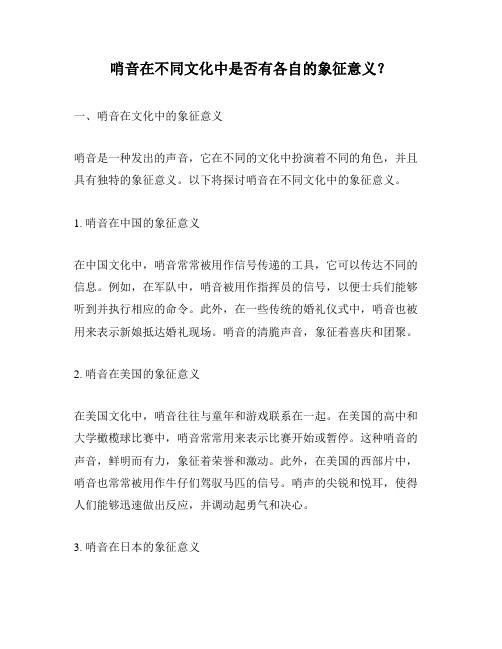
哨音在不同文化中是否有各自的象征意义?一、哨音在文化中的象征意义哨音是一种发出的声音,它在不同的文化中扮演着不同的角色,并且具有独特的象征意义。
以下将探讨哨音在不同文化中的象征意义。
1. 哨音在中国的象征意义在中国文化中,哨音常常被用作信号传递的工具,它可以传达不同的信息。
例如,在军队中,哨音被用作指挥员的信号,以便士兵们能够听到并执行相应的命令。
此外,在一些传统的婚礼仪式中,哨音也被用来表示新娘抵达婚礼现场。
哨音的清脆声音,象征着喜庆和团聚。
2. 哨音在美国的象征意义在美国文化中,哨音往往与童年和游戏联系在一起。
在美国的高中和大学橄榄球比赛中,哨音常常用来表示比赛开始或暂停。
这种哨音的声音,鲜明而有力,象征着荣誉和激动。
此外,在美国的西部片中,哨音也常常被用作牛仔们驾驭马匹的信号。
哨声的尖锐和悦耳,使得人们能够迅速做出反应,并调动起勇气和决心。
3. 哨音在日本的象征意义在日本文化中,哨音被广泛应用于各种仪式和表演。
例如,在传统的日本茶道中,哨音被用来表示茶具的移动和仪式的进行。
哨音的悠扬和细腻,使得整个仪式显得庄重而神秘。
此外,在一些传统的武士道演武中,哨音也被用来表示攻击和防守的节奏。
哨音的短促和有力,象征着武士们的果断和勇气。
二、哨音的文化差异尽管哨音在不同文化中都具有着象征意义,但不同文化对于哨音的解读和使用方式仍然存在较大的差异。
1. 音调与情绪的关联在不同文化中,对于哨音音调和情绪的关联有着不同的理解。
例如,在西方文化中,高音的哨音常常被用来表示喜悦和兴奋,而低音的哨音则常常与恐惧和紧张相关联。
然而,在东方文化中,对于哨音音调和情绪的关联则与西方有所不同,需要更加细致的研究和分析。
2. 社会文化背景的影响哨音的象征意义也受到社会文化背景的影响。
例如,在西方文化中,哨音通常被用作学校教室或工作场所的信号,以示工作开始或下课。
这与西方文化注重效率和时间管理的价值观相关联。
而在东方文化中,哨音的使用则相对较少,其传递信息的方式更多地通过语言和肢体表达。
文字的声音
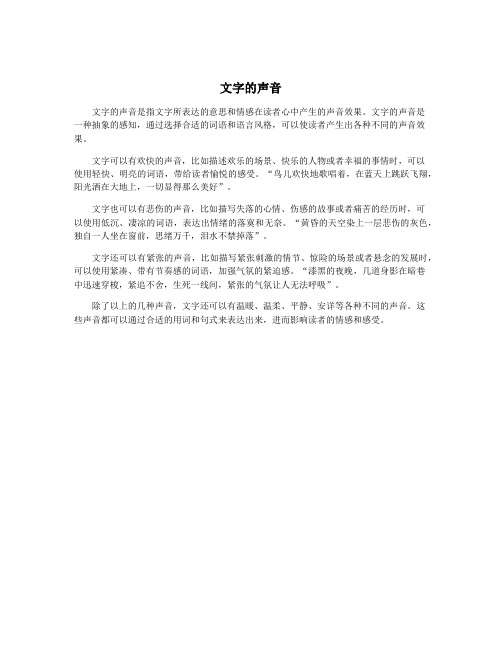
文字的声音
文字的声音是指文字所表达的意思和情感在读者心中产生的声音效果。
文字的声音是
一种抽象的感知,通过选择合适的词语和语言风格,可以使读者产生出各种不同的声音效果。
文字可以有欢快的声音,比如描述欢乐的场景、快乐的人物或者幸福的事情时,可以
使用轻快、明亮的词语,带给读者愉悦的感受。
“鸟儿欢快地歌唱着,在蓝天上跳跃飞翔,阳光洒在大地上,一切显得那么美好”。
文字也可以有悲伤的声音,比如描写失落的心情、伤感的故事或者痛苦的经历时,可
以使用低沉、凄凉的词语,表达出情绪的落寞和无奈。
“黄昏的天空染上一层悲伤的灰色,独自一人坐在窗前,思绪万千,泪水不禁掉落”。
文字还可以有紧张的声音,比如描写紧张刺激的情节、惊险的场景或者悬念的发展时,可以使用紧凑、带有节奏感的词语,加强气氛的紧迫感。
“漆黑的夜晚,几道身影在暗巷
中迅速穿梭,紧追不舍,生死一线间,紧张的气氛让人无法呼吸”。
除了以上的几种声音,文字还可以有温暖、温柔、平静、安详等各种不同的声音。
这
些声音都可以通过合适的用词和句式来表达出来,进而影响读者的情感和感受。
现代汉语

绪论一、定义1、语言:是一种特殊的社会现象,它是以语音为物质外壳,以词汇为建筑材料,以语法为结构规律而构成的符号系统。
2、与语言的功能:交际功能、思维功能、认知功能、记录功能、标记功能二、语言与民族、国家的关系三、语言的分类1、历时:母语、语系(汉藏语系使用人口最多,印欧语系影响最大)语族—语言—方言—次方言(土语)2、共时:综合性语言(形态语):俄语分析性语言(孤立语):汉语通过词汇表达语法意义四、现代汉语的意义1、现代汉语:狭义:现代汉语是现代汉民族所使用的语言,是以北京音为标准音,以北方话为基础方言,以典范的现代白话文著作为语法规范的普通话。
2、、北京音作为普通话的原因:政治原因、文化原因、北京音是最简单易学的。
五、现代汉语的变体(即方言)1、方言:北方方言、吴方言、湘方言、赣方言、客家方言、闽方言、粤方言2、社会变体(即社会方言):性格变体、年龄变体(青年变体和中老年变体)、行业变体(行业群体内部所使用的专业词汇和黑话)、阶层变体、社会变体六、现代汉语的特点语音:元音占优势,有声调、音乐性强、朗读起来抑扬顿挫词汇:双音节占优势语法:(1)现代汉语表示语法意义的手段主要用语序和虚词,大不用形态(即缺乏形态)。
形态:指表示语法意义的词形变化。
语法意义:通过现代汉语的形态所表达的意义。
(2)词、短语和句子的结构原则一致。
(3)词类和句法成分关系复杂。
(4)量词和语气词十分丰富。
第二章语音一、语音:是语言的物质外壳,是由人的发音器官发出的代表一定意义的声音。
二、属性:(一)物理属性(即语音四要素):音高、音强、音长、音色其中音高和音色决定普通话的意义1、音高:指的是声音的高低,它决定于发音体颤动的快慢。
(声调)2、音强:指的是声音的强弱,它与发音体颤动幅度的大小有关。
3、音长:指声音的长短,它取决于发音体颤动时间的久暂。
4、音色:又叫“音质”,指的是声音的特色。
音色的差别主要决定于物体颤动所形成的音波波纹的曲折形式不同。
一文带你了解“声”和”音“有什么区别?

一文带你了解“声”和”音“有什么区别?在现代汉语中,我们似乎已经习惯于将”声“和”音“等同,并用“声音”来描述能引起人类听觉感知的一切振动。
但从沿袭的习惯用语来看,对于不同的“声音”的描述,似乎又总是存在“声”与“音”不同的侧重。
对于某些声音,我们会侧重于用“声”去描述,比如“雷声,雨声,鼓声,歌声,爆竹声......”,而有些声音,我们则会侧重于用“音”去描述,比如“语音,嗓音,乐音,余音绕梁......”那么“声”与“音”到底有什么区别呢,今天就让我们一起来揭秘吧!我们首先从字形的角度来观察“声”与“音”最初的字形构造,理解其造字本义。
“声”字的甲骨文字体的左上角为古代乐器磬,字的右面为手执棒槌作敲磬状,字的中间部分代表耳朵,左下角是“口”;“耳”和“口”两部分合起来是甲骨文的“听”。
整个字的意义是击磬的乐音,进入耳朵,就是“声”了。
“音”字与“言”同源,在“言”字上加几点即为“音”,表示所言说的内涵,即“言”里的心声。
造字本义是指说出的话,话语中包含的心声。
“音”的金文则像口吹萧管喇叭等乐器,逐渐用以指代乐音。
图1 “声”字的甲骨文图2 “音”字的金文从“声”与“音”的字形出发,逐渐衍生出了人们对于两者不同的理解。
“声”字的字形中包含了击打的动作,因此引申而来将一切因外物作用于物体而发出的声响称之为“声”。
而“音”字与言同源,因此引申用以指代生物本身依靠发音器官所发出来的“音”。
从古人的文学作品中对于不同的声音的描述方式,我们也可以窥见其对于“声”与“音”的辨析。
“闻水声,如鸣佩环”、“姑苏城外寒山寺,夜半钟声到客船”、“爆竹声中一岁除,春风送暖入屠苏”揭示了古人对外界相互作用而发出的声响普遍用“声”来描述的习惯;而“鸡狗之音相闻”、“冰雪,无瀑水,无鸟兽音迹”、“乡音无改鬓毛衰”则可见“音”的使用场景之于“声”的区别。
随着语言的发展,“声”与“音”的含义也有了进一步的发展。
我们可以从后续的语言使用习惯发现,“声”从外物作用之声逐渐发展为自然界一切机械振动所引发的声音的统称,其使用范围更广泛,往往针对具体的声音。
现代汉语知识点大全:语音

现代汉语知识点大全:语音语音1是语言的物质外壳,代表一定意义的声音就是语音。
2声音的高低,决定于发音体在一定时间内颤动次数的多少。
3声音的强弱,也叫音势或音量,决定于一定时间内音波振动幅度的大小。
4声音的长短,它决定于发音体振动音波持续时间的长短。
5又叫“音质”,指的是声音的个性、特色,音色的差别主要决定于物体振动所形成的音波波纹的曲折形式不同。
6音节是语音结构的基本单位,是听觉上最容易分辨出来的语音单位,也是自然感到的最小的语音片断7是构成音节的最小单位或最小的语音片断,它是从音色的角度划分的。
8、音位:是一个语音系统中能够区别意义的最小语音单位,也就是按语音的辨义作用归纳出的音类。
9、塞音:发音时发音部位的某两个部分完全闭合,从肺部出来的气流积聚在受阻碍部分,阻塞部分突然打开,气流迸裂而出,造成爆发色彩的音。
10、擦音:发音时发音部位的某两个部分靠近,形成缝隙,气流从缝隙挤出,造成摩擦音。
11、塞擦音:发音时发音部位的某两个部分完全闭合,阻住气流,然后逐步放开,形成一条窄缝,让气流从窄缝挤出,造成塞擦音。
12、鼻音:发音时软腭下垂,鼻腔通路打开,口腔里形成阻碍的两部分完全闭合,气流不能从口腔通过,转道鼻腔流出,发出鼻音。
13发音时舌尖和上腭的某一点接触,形成阻碍,舌的两边松弛、自然,气流沿舌的两边(或一边)流出,造成边音。
14有一些音节的开头不是辅音而是元音,这就是说,它们的声母是“零”,所以把不用辅音充当声母的字称为“零声母字”。
15传统的分析法把音节里开头的辅音字母叫声母。
16传统的分析法把音节里声母后面的部分叫做韵母。
17把两个以上韵母相同或相近的字放在诗句的同一位置上,使声音和谐悦耳,这种情况就叫做押韵(或压韵)。
18贯穿整个字音的高低升降,这就是声调,汉语的一个音节基本上是一个汉字,所以声调也叫字调。
19是指音节高低升降曲直长短的变化形式,也就是声调的实际读法。
20、调类:声调的分类,是按照声调的实际读法归纳出来的。
简述汉语四声的意义

简述汉语四声的意义
汉语四声是指汉语中的四种声调,它们分别是平声、上声、去声和入声。
每个声调都有自己独特的意义和作用,对于理解和学习汉语来说至关重要。
平声是指声调平稳,音高基本不变的声调。
它表示一种平静、稳定的状态,常用于表达客观事实或描述事物的属性。
例如,"书"这个字的读音就是平声,表示一种实物。
上声是指声调由低到高的声调。
它表示一种上升、扩张的趋势,常用于表达肯定、祝福或赞扬的意思。
例如,"好"这个字的读音就是上声,表示一种积极的情感。
去声是指声调由高到低的声调。
它表示一种减弱、收缩的趋势,常用于表达否定、警告或批评的意思。
例如,"不"这个字的读音就是去声,表示一种否定的情绪。
入声是指声调由低到高再由低到中的声调。
它表示一种进入、沉浸的状态,常用于表达感官的体验或描述动作的进行。
例如,"吃"这个字的读音就是入声,表示一种动作的进行。
汉语四声的意义不仅仅是在语言交流中起到了区分词义的作用,更是汉语文化的重要组成部分。
它们不仅仅是一种语音现象,更是一种情感表达和文化传承的方式。
通过正确运用四声,我们能够更准确地表达自己的意思,传递自己的情感。
因此,学习和掌握汉语四
声是学习汉语的基础,也是了解中国文化的窗口。
无论是在学习、工作还是生活中,都应该注重发音准确,运用得当,以确保有效的沟通和交流。
现代汉语中声音象征意义
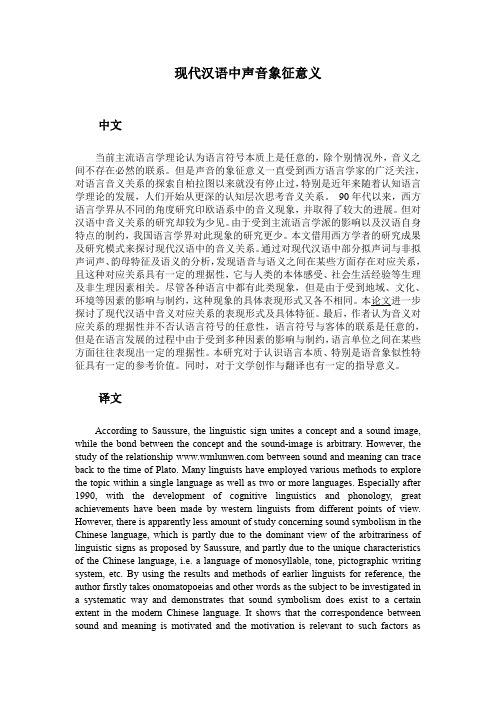
现代汉语中声音象征意义中文当前主流语言学理论认为语言符号本质上是任意的,除个别情况外,音义之间不存在必然的联系。
但是声音的象征意义一直受到西方语言学家的广泛关注,对语言音义关系的探索自柏拉图以来就没有停止过,特别是近年来随着认知语言学理论的发展,人们开始从更深的认知层次思考音义关系。
90年代以来,西方语言学界从不同的角度研究印欧语系中的音义现象,并取得了较大的进展。
但对汉语中音义关系的研究却较为少见。
由于受到主流语言学派的影响以及汉语自身特点的制约,我国语言学界对此现象的研究更少。
本文借用西方学者的研究成果及研究模式来探讨现代汉语中的音义关系。
通过对现代汉语中部分拟声词与非拟声词声、韵母特征及语义的分析,发现语音与语义之间在某些方面存在对应关系,且这种对应关系具有一定的理据性,它与人类的本体感受、社会生活经验等生理及非生理因素相关。
尽管各种语言中都有此类现象,但是由于受到地域、文化、环境等因素的影响与制约,这种现象的具体表现形式又各不相同。
本论文进一步探讨了现代汉语中音义对应关系的表现形式及具体特征。
最后,作者认为音义对应关系的理据性并不否认语言符号的任意性,语言符号与客体的联系是任意的,但是在语言发展的过程中由于受到多种因素的影响与制约,语言单位之间在某些方面往往表现出一定的理据性。
本研究对于认识语言本质、特别是语音象似性特征具有一定的参考价值。
同时,对于文学创作与翻译也有一定的指导意义。
译文According to Saussure, the linguistic sign unites a concept and a sound image, while the bond between the concept and the sound-image is arbitrary. However, the study of the relationship between sound and meaning can trace back to the time of Plato. Many linguists have employed various methods to explore the topic within a single language as well as two or more languages. Especially after 1990, with the development of cognitive linguistics and phonology, great achievements have been made by western linguists from different points of view. However, there is apparently less amount of study concerning sound symbolism in the Chinese language, which is partly due to the dominant view of the arbitrariness of linguistic signs as proposed by Saussure, and partly due to the unique characteristics of the Chinese language, i.e. a language of monosyllable, tone, pictographic writing system, etc. By using the results and methods of earlier linguists for reference, the author firstly takes onomatopoeias and other words as the subject to be investigated in a systematic way and demonstrates that sound symbolism does exist to a certain extent in the modern Chinese language. It shows that the correspondence between sound and meaning is motivated and the motivation is relevant to such factors ashuman experiences, culture backgrounds, psychological attributes, physiological characters, etc. Though sound symbolism can be found in nearly all-human languages, its representations vary from language to language. Then, special attention has been focused on the study of sound symbolism as it relates to size symbolism in the Chinese language, symbolism motivated by the sense of sight, the Chinese tone, the Chinese culture, gender difference in the spoken Chinese, etc. Finally, the author claims that the linguistic motivation is not in contradiction with the arbitrary nature of linguistic sign. Arbitrariness refers to the relationship between the linguistic sign and the object in reality is arbitrary, while linguistic motivation refers to that certain associative meanings could be found between different linguistic units. Theoretically, this study serves as a reference for a better understanding of the nature of human language systems, especially for language iconicity. Practically, this study might provide some insights for writing, translation, naming, etc.。
萧红散文中声音意象的情感隐喻
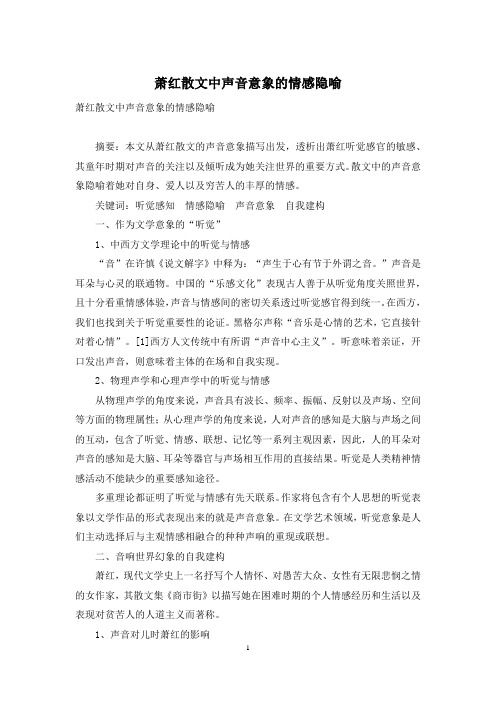
萧红散文中声音意象的情感隐喻萧红散文中声音意象的情感隐喻摘要:本文从萧红散文的声音意象描写出发,透析出萧红听觉感官的敏感、其童年时期对声音的关注以及倾听成为她关注世界的重要方式。
散文中的声音意象隐喻着她对自身、爱人以及穷苦人的丰厚的情感。
关键词:听觉感知情感隐喻声音意象自我建构一、作为文学意象的“听觉”1、中西方文学理论中的听觉与情感“音”在许慎《说文解字》中释为:“声生于心有节于外谓之音。
”声音是耳朵与心灵的联通物。
中国的“乐感文化”表现古人善于从听觉角度关照世界,且十分看重情感体验,声音与情感间的密切关系透过听觉感官得到统一。
在西方,我们也找到关于听觉重要性的论证。
黑格尔声称“音乐是心情的艺术,它直接针对着心情”。
[1]西方人文传统中有所谓“声音中心主义”。
听意味着亲证,开口发出声音,则意味着主体的在场和自我实现。
2、物理声学和心理声学中的听觉与情感从物理声学的角度来说,声音具有波长、频率、振幅、反射以及声场、空间等方面的物理属性;从心理声学的角度来说,人对声音的感知是大脑与声场之间的互动,包含了听觉、情感、联想、记忆等一系列主观因素,因此,人的耳朵对声音的感知是大脑、耳朵等器官与声场相互作用的直接结果。
听觉是人类精神情感活动不能缺少的重要感知途径。
多重理论都证明了听觉与情感有先天联系。
作家将包含有个人思想的听觉表象以文学作品的形式表现出来的就是声音意象。
在文学艺术领域,听觉意象是人们主动选择后与主观情感相融合的种种声响的重现或联想。
二、音响世界幻象的自我建构萧红,现代文学史上一名抒写个人情怀、对愚苦大众、女性有无限悲悯之情的女作家,其散文集《商市街》以描写她在困难时期的个人情感经历和生活以及表现对贫苦人的人道主义而著称。
1、声音对儿时萧红的影响萧红的童年孤独寂寞。
弗洛伊德说:“一种经验如果在一个很短暂的时期内,使心灵受一种最高度的刺激,以致不能用正常的方法谋求适应,从而使心灵的有效能力的分配受到永久的扰乱,我们便称这种经验为创伤的。
声与音的区别
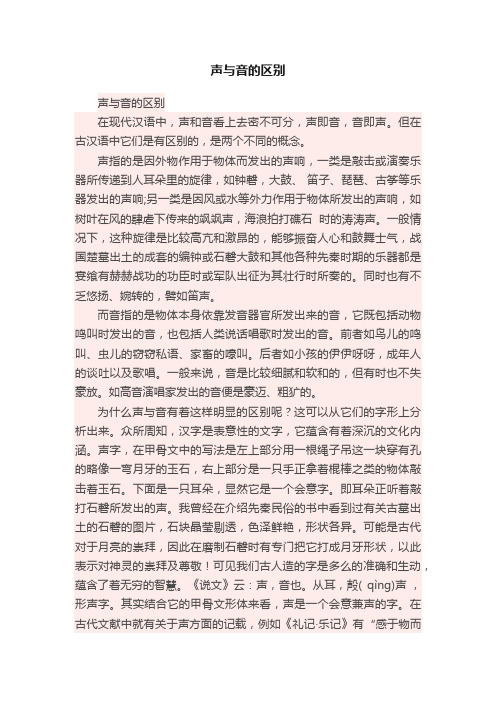
声与音的区别声与音的区别在现代汉语中,声和音看上去密不可分,声即音,音即声。
但在古汉语中它们是有区别的,是两个不同的概念。
声指的是因外物作用于物体而发出的声响,一类是敲击或演奏乐器所传递到人耳朵里的旋律,如钟磬,大鼓、笛子、琵琶、古筝等乐器发出的声响;另一类是因风或水等外力作用于物体所发出的声响,如树叶在风的肆虐下传来的飒飒声,海浪拍打礁石时的涛涛声。
一般情况下,这种旋律是比较高亢和激昂的,能够振奋人心和鼓舞士气,战国楚墓出土的成套的编钟或石磬大鼓和其他各种先秦时期的乐器都是宴飨有赫赫战功的功臣时或军队出征为其壮行时所奏的。
同时也有不乏悠扬、婉转的,譬如笛声。
而音指的是物体本身依靠发音器官所发出来的音,它既包括动物鸣叫时发出的音,也包括人类说话唱歌时发出的音。
前者如鸟儿的鸣叫、虫儿的窃窃私语、家畜的嚎叫。
后者如小孩的伊伊呀呀,成年人的谈吐以及歌唱。
一般来说,音是比较细腻和软和的,但有时也不失豪放。
如高音演唱家发出的音便是豪迈、粗犷的。
为什么声与音有着这样明显的区别呢?这可以从它们的字形上分析出来。
众所周知,汉字是表意性的文字,它蕴含有着深沉的文化内涵。
声字,在甲骨文中的写法是左上部分用一根绳子吊这一块穿有孔的略像一弯月牙的玉石,右上部分是一只手正拿着棍棒之类的物体敲击着玉石。
下面是一只耳朵,显然它是一个会意字。
即耳朵正听着敲打石磬所发出的声。
我曾经在介绍先秦民俗的书中看到过有关古墓出土的石磬的图片,石块晶莹剔透,色泽鲜艳,形状各异。
可能是古代对于月亮的崇拜,因此在磨制石磬时有专门把它打成月牙形状,以此表示对神灵的崇拜及尊敬!可见我们古人造的字是多么的准确和生动,蕴含了着无穷的智慧。
《说文》云:声,音也。
从耳,殸( qìng)声,形声字。
其实结合它的甲骨文形体来看,声是一个会意兼声的字。
在古代文献中就有关于声方面的记载,例如《礼记·乐记》有“感于物而动,故形于声”的说法,著名诗人白居易在代表作《琵琶行》中写道:“寻声暗问弹者谁?琵琶声停欲语迟。
声音的意义.徐建顺.打印

声音的意义徐健顺著(徐建顺,首都师范大学教授,中华吟诵协会秘书长)目录:一、汉诗文首先是声音的作品二、汉字是音形义的统一体三、关于任意性原则的讨论四、汉语语音是有意义的五、汉诗文的读法六、汉诗文的意义是音义与字义之和七、汉诗文的声音意义——押韵七、汉诗文的声音意义——声调八、汉诗文的声音意义——平仄九、汉诗文的声音意义——虚字十、汉诗文的声音意义——文体十一、汉诗文声音的功能——诗教十二、汉诗文声音的功能——乐教声音的意义徐健顺百年以来,中国学界引进西方理论,研究、阐释、传承汉诗文,取得了很多新见解新成果,但是,也形成了一些不太正确的研究定势,比如,不重视声音的意义。
因为西方理论是在印欧语系的基础上创造出来的,印欧语系基本上是重音语言,有重音没声调,而汉语属于汉藏语系,有声调没重音。
语言的巨大反差,造成了西方理论在解释汉诗文的声音意义方面苍白无力,所以中国学界近百年来形成了忽略、回避、放弃声音研究的习惯。
实际上,汉诗文首先是声音的作品,离开了声音的阐释,对汉诗文的理解是很难准确、深入的。
本文即在作者多年采录研究吟诵的基础上,希望对汉诗文的声音的意义,做一次初步的研究探索。
一、汉诗文首先是声音的作品1931年2月20日,鲁迅悲愤于“左联”五青年被害,在上海租界逃避追捕的夜里,写下了名文《为了忘却的记念》,其中有这样一段:在一个深夜里,我站在客栈的院子中,周围是堆着的破烂的什物;人们都睡觉了,连我的女人和孩子。
我沉重的感到我失掉了很好的朋友,中国失掉了很好的青年,我在悲愤中沉静下去了,然而积习却从沉静中抬起头来,凑成了这样的几句:惯于长夜过春时,挈妇将雏鬓有丝。
梦里依稀慈母泪,城头变幻大王旗。
忍看朋辈成新鬼,怒向刀丛觅小诗。
吟罢低眉无写处,月光如水照缁衣。
”这首诗即是鲁迅的名作七律《无题》。
第三联“觅小诗”,就是要作诗的意思。
如果是寻觅一首前人的诗,那又何必“写”呢?所以,鲁迅是说,他因朋辈之死而愤怒,要作诗了。
- 1、下载文档前请自行甄别文档内容的完整性,平台不提供额外的编辑、内容补充、找答案等附加服务。
- 2、"仅部分预览"的文档,不可在线预览部分如存在完整性等问题,可反馈申请退款(可完整预览的文档不适用该条件!)。
- 3、如文档侵犯您的权益,请联系客服反馈,我们会尽快为您处理(人工客服工作时间:9:00-18:30)。
现代汉语中声音象征意义
中文
当前主流语言学理论认为语言符号本质上是任意的,除个别情况外,音义之间不存在必然的联系。
但是声音的象征意义一直受到西方语言学家的广泛关注,对语言音义关系的探索自柏拉图以来就没有停止过,特别是近年来随着认知语言学理论的发展,人们开始从更深的认知层次思考音义关系。
90年代以来,西方语言学界从不同的角度研究印欧语系中的音义现象,并取得了较大的进展。
但对汉语中音义关系的研究却较为少见。
由于受到主流语言学派的影响以及汉语自身特点的制约,我国语言学界对此现象的研究更少。
本文借用西方学者的研究成果及研究模式来探讨现代汉语中的音义关系。
通过对现代汉语中部分拟声词与非拟声词声、韵母特征及语义的分析,发现语音与语义之间在某些方面存在对应关系,且这种对应关系具有一定的理据性,它与人类的本体感受、社会生活经验等生理及非生理因素相关。
尽管各种语言中都有此类现象,但是由于受到地域、文化、环境等因素的影响与制约,这种现象的具体表现形式又各不相同。
本论文进一步探讨了现代汉语中音义对应关系的表现形式及具体特征。
最后,作者认为音义对应关系的理据性并不否认语言符号的任意性,语言符号与客体的联系是任意的,但是在语言发展的过程中由于受到多种因素的影响与制约,语言单位之间在某些方面往往表现出一定的理据性。
本研究对于认识语言本质、特别是语音象似性特征具有一定的参考价值。
同时,对于文学创作与翻译也有一定的指导意义。
译文
According to Saussure, the linguistic sign unites a concept and a sound image, while the bond between the concept and the sound-image is arbitrary. However, the study of the relationship between sound and meaning can trace back to the time of Plato. Many linguists have employed various methods to explore the topic within a single language as well as two or more languages. Especially after 1990, with the development of cognitive linguistics and phonology, great achievements have been made by western linguists from different points of view. However, there is apparently less amount of study concerning sound symbolism in the Chinese language, which is partly due to the dominant view of the arbitrariness of linguistic signs as proposed by Saussure, and partly due to the unique characteristics of the Chinese language, i.e. a language of monosyllable, tone, pictographic writing system, etc. By using the results and methods of earlier linguists for reference, the author firstly takes onomatopoeias and other words as the subject to be investigated in a systematic way and demonstrates that sound symbolism does exist to a certain extent in the modern Chinese language. It shows that the correspondence between sound and meaning is motivated and the motivation is relevant to such factors as
human experiences, culture backgrounds, psychological attributes, physiological characters, etc. Though sound symbolism can be found in nearly all-human languages, its representations vary from language to language. Then, special attention has been focused on the study of sound symbolism as it relates to size symbolism in the Chinese language, symbolism motivated by the sense of sight, the Chinese tone, the Chinese culture, gender difference in the spoken Chinese, etc. Finally, the author claims that the linguistic motivation is not in contradiction with the arbitrary nature of linguistic sign. Arbitrariness refers to the relationship between the linguistic sign and the object in reality is arbitrary, while linguistic motivation refers to that certain associative meanings could be found between different linguistic units. Theoretically, this study serves as a reference for a better understanding of the nature of human language systems, especially for language iconicity. Practically, this study might provide some insights for writing, translation, naming, etc.。
